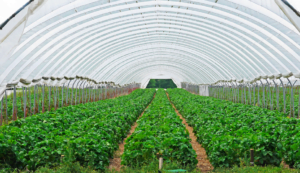News
CPP Wind helps indoor farms produce optimal yields
 Here’s a vexing truth: the highest demand for fresh produce originates where produce farms are rarest. By the time fresh veggies have traveled from farm to table, the freshness might be gone.
Here’s a vexing truth: the highest demand for fresh produce originates where produce farms are rarest. By the time fresh veggies have traveled from farm to table, the freshness might be gone.
But the marketplace has responded with indoor farming. Niche operators may focus on a single crop. Major operations may grow lettuce, spinach, arugula and other staples of today’s healthy diets. A single facility may farm hundreds of thousands of square feet of growth surfaces, which tend to be layered for optimal space utilization. Indoor farms stack. A twenty-foot vertical elevation might contain six or seven layers of fertile growth surface.
But as many indoor farmers are discovering, such tight proximity restricts airflow, which restricts yields. Additionally, indoor farming depends upon artificial light, which generates heat, and trapped heat affects yields.
Simply put, without the right volume of air reaching every plant with the appropriate temperature and humidity levels, plants don’t thrive. Consequently, the farmer’s bottom line suffers.
Many indoor farmers have tackled airflow problems piecemeal. They may experiment on a small scale, placing discount-store fans around the perimeter and aiming the flow inward in hopes of achieving better results. Not only do these efforts fail, scaling to serve the entire facility proves costly.
At the forefront of a growing industry, CPP offers a better approach. We spoke with CPP’s Peter Bourke and Isabelle Lavedrine. “We perform parametric studies,” Lavedrine explains, “that take into account temperature, humidity, airflow, and so many factors that influence these readings.”
Building upon experience, expertise and proven methodologies from across the organization, CPP’s computer simulations apply the thermodynamics and physics necessary to solve complicated scientific challenges. “The tools are quite sophisticated,” says Bourke, “requiring massive arrays of computers. Not the type of analysis an individual business owner could run on a laptop.”
CPP advises clients to involve them early, before the farm building is constructed. Superior crop yields might only be achieved with ideal vent positions, a predefined air distribution network, and precise fan placement and scheduled operation. “Crops grow in relatively flat trays or boxes,” says Lavedrine. “The spacing, both horizontally and vertically, around these containers directly impacts temperature, humidity and flow. We can do it right, but if we get involved after such decisions are made, we’re limited to Band-Aid approaches.”
What stands in the way of the best solutions? “Cost concerns,” says Bourke. “But once the farmer understands the huge impact on yields, the need for upfront investment becomes clear.”
A project engagement typically starts delivering results within a few weeks. Ongoing tweaking to achieve the best results can continue for another month or two.
Contact us today to learn more about how CPP Wind’s analytical services can help indoor farms improve yields through optimized air circulation.
